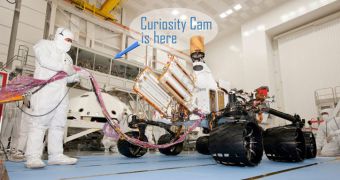The next-generation Martian rover that NASA will deploy on the Red Planet, called Curiosity, apparently inspired the same feeling in the general public as well. After a live webcam showing work being carried out to construct it was brought online, more than 1 million people flocked to log on.
The “Curiosity Cam” operate nearly around the clock, and allows those who're interested to keep an eye on the way work is progressing on the massive robotic explorer.
Unlike the twin Mars Exploration Rovers Spirit and Opportunity, the Mars Science Laboratory (MSL) is very large, almost the size of a Mini Cooper. It is also the largest rover to be taken to the Red Planet, tipping the scales at around 1 ton.
There is a large number of firsts that will be applied to this instrument, and naturally everyone at NASA is excited about the upcoming mission. At this point, the American space agency wants to launch the mission in late 2011.
Construction efforts are taking place in Pasadena, California, at the NASA Jet Propulsion Laboratory (JPL). The organization, which is managed by the California Institute of Technology (Caltech), will be responsible for managing the $2.3 billion mission.
The webcam installed in a JPL clean room shows engineers and technicians going about their daily business, putting the new, nuclear-powered rover together. When the live feed was turned on, no one was expecting to be so successful.
In the month between October 21 and November 23, more than 1 million unique viewers logged on to the webcam, and spent more than 400,000 combined hours watching the transmission.
Officials at the JPL say that the rover camera is installed in the viewing gallery of the lab's Spacecraft Assembly Facility (SAF), which provides an excellent vantage point.
Constructing the rover is one of the most complex tasks ever undertaken at NASA, explain officials at the space agency. But the scientific return of the instrument is also expected to be larger than that of any other previous mission.
The goal of the mission is to search for signs to indicate that microbial life was or still is possible on the surface of the Red Planet. At this point, NASA has yet to decide where it will land the rover. There are currently about four location undergoing rigorous scientific scrutiny.
The explorations robot will take off from the Cape Canaveral Air Force Station (CCAFS), in Florida, between November 25 and December 18 2011, and is scheduled to reach the Red Planet in August 2012, Space reports.

 14 DAY TRIAL //
14 DAY TRIAL //